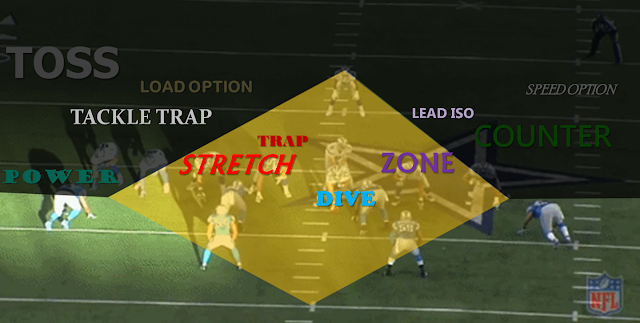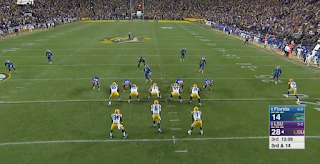Inspired by the insightful post of Alex Kirby at Life After Football , I wanted to offer feedback on this same process with an emphasis
on developing a routine for interpreting live football broadcasts. The method
I'll outline is one that I've used for years while being in the box for gameday
communication.
What
we'll outline here is how to assess the next play that is going to be run
before that play starts. The beauty here
is this is a skill you can hone with hundreds of reps at your leisure. Likely,
you will already be watching 12 hours of football each weekend that you can
practice with. Let's assume you watch 3 or 4 football games in a weekend.
That translates to roughly 450 - 500 repetitions to train your brain with
instant feedback to develop this skill. This allows you to stay engaged with
any broadcast, playing this game (within a game broadcast) but also developing
a skillset invaluable to football coordinating.
Watching games dispassionately, just focusing on formations and areas of
the field, allows you to develop an
intelligence towards predicting outcomes.
Naturally, the type of plays called will depend on the play-caller, but
those become exceptions to the rule. The
more you exercise this technique, the more scenarios you will have to draw from
because you will receive instant feedback once the play is run (were you right
or wrong? What did you learn from your hypothesis?).
When all is said and done, it really is the commander's coup d'œil, his ability to see things simply, to identify the whole business of war completely with himself, that is the essence of good generalship. Only if the mind works in this comprehensive fashion can it achieve the freedom it needs to dominate events and not be dominated by them. -Carl von Clausewitz
The intent of this exercise is to use the 25 second play clock to assess what is on the field and the possible outcomes after the ball is snapped. The goal here is to consolidate all the information you see on the field and assume the probable outcome within 15 seconds, leaving 10 seconds on the play clock. I believe if you examine the game from a defensive mindset, it becomes easier to process what transpires after the snap and compartmentalize the components of a play, making your viewing experience more enjoyable. The following represents a cascading punchlist of data elements you will use to deduce a probable outcome in a given situation.
3 Seconds
This bit of
information can be garnered immediately after a play has concluded.
Field position - where
at on the field is the offense trying to advance the ball? When backed up
inside their own 20, offense will be looking simply to convert the down and get
out of the shadow of their own end zone. Between the 40s, the objective is
looking to break an explosive play to reach the red zone. Inside the red
zone, offense look to take advantage of the limited depth of the field (usually
resulting in some form of man-to-man coverage) for a score.
Down and Distance - the
area of the field and distance for the conversion influences offenses on how
aggressive they will need to be while mitigating a negative yardage play.
Time remaining - more often than not, this really only matters in
the 4th quarter in a close game. Depending on the momentum the offense is
in, you can start reducing the time remaining by the average drive duration and
figure out how many possessions are left before the game expires. If
there are 10 minutes left in the game and the offense is trailing by more than
10, they would need to operate under the assumption that they'll only have 2-3
possessions left in the game and need to quicken the pace or reach for more
explosive plays.
Hash - this makes a big
difference outside of NFL, where the field width can magnify the space between
the ball and the furthest receiver. The chasm makes it difficult for
defenses to disguise their intentions (coverage/pressure).
Personnel - what kind
of players are in the game? The offense
has run 3 tight ends on the field. Okay, we're probably not expecting a vertical passing concept. Some network television broadcasts have begun listing personnel between plays.
7 Seconds
Pare down the
unknowns by paying attention to the formation and how the defense matches with
their front.
Formations
3-man
surface: Pro strength or compressed trips?
1-back/2-back:
21 personnel? Find exceptions on why they won't be running Power/Iso because
that is probably what is coming.
Balanced
/ unbalanced: is the formation symmetrical (expect it to be, then work
the exception), is there more numbers to a side of the field, are there more
than 3 players on one side of the ball?
What is the run strength of the formation (assume they will run to
this side)? Is there a TE or H-back added to the box ?
Slot: What I'm looking for most often is what is the span of the slot (2 receivers) and how the defensive backs align (how deep are they? Inside/outside leverage?).
Slot: What I'm looking for most often is what is the span of the slot (2 receivers) and how the defensive backs align (how deep are they? Inside/outside leverage?).
- Is it slot (where is the potential #3 receiver) or trips (is the single receiver closed/split or to the field)?
- Are the receivers compressed - what grass are they squeezing you to get?
- Is it to the field? If so, where are they in relation to the numbers, to the hash?
- Is the back offset? To or away from the field?
Defense matchup
The shell of the defensive coverage is a good indication of how
the defense will respond and give a tip of who the force player will be
(safety, corner, backer, end?).
As an example, if you see twins to the field and you have 2
defenders over these receivers no deeper than 5 yards with a safety over the
top (in relation to both), assume a run inside because that would likely be the
most successful scenario simply by the numbers remaining in the box.
- Determine the slot coverage being used here; will it be man or will someone drop to cover the curl/flat?
- Is the front playing even or odd? Is the center covered (nose) or are they playing shades?
- How many rushing threats are in the box? Who would the offense declare the mike and slide coverage away from?
- Are there any "out-of-box" defenders in close proximity to the box to be included as a potential rusher/primary run support defender?
Use this
information to start making logical assumptions. Eliminate the exceptions and
determine the most probable plays to run.
12 Seconds
12 Seconds
Leverage / Matchup -
What is the target of opportunity? What is the most plausible
scenario given this front/coverage and formation?
Example: You're watching Iowa
offense. It's 2nd and 8, at mid-field and they come out in 12 personnel with
double-tight Ace. Assume they are going
to run stretch until you see something glaringly obvious (safeties drop down or
a receiver motions across the formation).
This also helps you visualize any support fits of the defense and who is going to be in the best position to make the play on defense. Use the example above, you expect an immediate inside run, what defender could present the biggest problem. If they run zone left, which defender would be in the best position (just by alignment) to make the play on the ball carrier?
list the probabilities, then select the most appropriate response
16 - 20 Seconds
Reassess
what you've just assumed. What have
these teams been successful with? What is necessary just to convert the down?
Visualize
how your assumed play will run against the given defense. How will that play be blocked and what are
the risks to this play being successful?
Post-Snap
What is the first step at the snap? Is it flow / web / split
action by the backs? Is that congruent with where the line is going?
Did anything happen that contradicts what you assumed would
happen?
* this is actually a game I used to have our linebackers play during film study, where we would show opponent film one frame at a time. The winner would be the first guy to call out the play being run (based on the fewest frames/steps).
* this is actually a game I used to have our linebackers play during film study, where we would show opponent film one frame at a time. The winner would be the first guy to call out the play being run (based on the fewest frames/steps).
The bottom line is compile all the presnap data, determine the
likely scenarios, then once the ball is snapped find the exceptions that would
immediately alert you of the special play (blitz, counter, play-action,
screen).
Example: if either of these safeties in a 2-high look were to
drop, immediately we know we have an alert that could become pressure or an
indicator that the safety is playing zone and will be covering the
curl/flat area (looking for back out to his side / perimeter run defender).
Does the other safety rotate to the middle of the field or does he jump the
slot receiver on his side (telling you the middle of the field is wide open)
When you
look at the game this way, it eliminates a lot of the unknowns when the ball is
snapped. When you do this, you have the capability to focus on seeing
technique, particularly on the pivotal players needed to make the play
successful (i.e. a pulling guard in space on sweep).
This exercise is a great practice to condition your mind to interpret on-field patterns. This is also why I am a big fan of watching games via ESPN 3's Spidercam or just reviewing presnap alignment pictures on your own. Using the 6-10 seconds of presnap post-huddle alignments as a sort of football Rorschach Test, you quickly have to interpret what you see and list all the possible conclusions that would take place simply by leverage of each player.
I hope
this has provided a framework to enjoy broadcasts while strengthening your
"football IQ" to build off
of. We welcome your feedback, so drop your recommendations or concerns in
the comments section below.












No comments:
Post a Comment